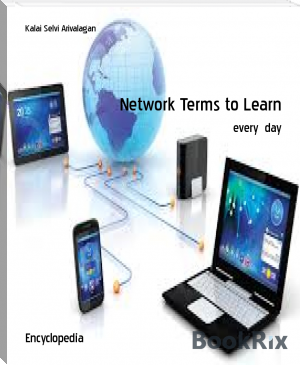Network Terms to Learn - Kalai Selvi Arivalagan (best love novels of all time .TXT) 📗

- Author: Kalai Selvi Arivalagan
Book online «Network Terms to Learn - Kalai Selvi Arivalagan (best love novels of all time .TXT) 📗». Author Kalai Selvi Arivalagan
Hybrid Encryption
Hybrid encryption is a mode of encryption that merges two or more encryption systems. It incorporates a combination of asymmetric and symmetric encryption to benefit from the strengths of each form of encryption. These strengths are respectively defined as speed and security. Hybrid encryption is considered a highly secure type of encryption as long as the public and private keys are fully secure.
Elegant Solution
An elegant solution is used in mathematics, engineering and software development to refer to a solution that solves the problem in the simplest and most effective manner. In many cases, it is possible for developers to created code that is more complicated than it needs to be. In such cases, this less-than-elegant code is more likely to cause other issues. For most developers, finding an elegant solution is a greater challenge than simply solving a problem.
Big Data Management
Big data management refers to the efficient handling, organization or use of large volumes of structured and unstructured data belonging to an organization.
Dynamic Hashing
Dynamic hashing is a database process in which the contents of data "buckets" (or other container systems) can grow or shrink in order to accommodate a hashing technique.
Big Data Platform
Big data platform is a type of IT solution that combines the features and capabilities of several big data application and utilities within a single solution. It is an enterprise class IT platform that enables organization in developing, deploying, operating and managing a big data infrastructure/environment.
Machine Vision System
A machine vision system (MVS) is a type of technology that enables a computing device to inspect, evaluate and identify still or moving images. It is a field in computer vision and is quite similar to surveillance cameras, but provides automatic image capturing, evaluation and processing capabilities.
Blockchain
Blockchain is a critical part of the bitcoin peer-to-peer payment system. The bitcoin system works using a blockchain ledger to record transactions. Bitcoin is a global cryptocurrency that can be used as a medium of exchange. However, while many parties have started to accept bitcoin as a currency, it is still controversial and poses risks in terms of security and stability.
Bitcoin Mining
Bitcoin mining is the process of creating, or rather discovering, bitcoin currency. Unlike real-world money that is printed when more is needed, bitcoin cannot simply be willed into existence, but has to be mined through mathematical processes. Bitcoin maintains a public ledger that contains past transactions, and mining is the process of adding new transactions to this ledger.
Smart Television (Smart TV)
Smart television (smart TV) is TV that provides interactive features similar to those involved in Internet or Web services. This includes the ability to search for video or interact with the television in other ways. This can be done through a set-top box or through internal technology in the television, such as an operating system that commands and controls these interactive features. Smart TV is also called connected TV or hybrid TV.
Degenerate Strategy
A degenerate strategy is a way of playing a video game that exploits an oversight in gameplay mechanics or design. Degenerate strategies apply to player-versus-player (PvP) as well as player versus environment (PvE) games. Degenerate strategies do not break the rules of a game like a code or a cheat, but they do prevent the game from being experienced in the manner intended by the game designer.
Dogecoin
Dogecoin is a dog-themed cryptocurrency pioneered in 2013, an alternative to more famous choices like bitcoin. Although the value of an individual Dogecoin is very small (often a portion of a cent) the massive number of Dogecoins in circulation correlates to a market capitalization of over $1 billion.
Private Cloud Storage
Private cloud storage is a type of storage mechanism that stores an organization's data at in-house storage servers by implementing cloud computing and storage technology. Private cloud storage is similar to public cloud storage in that it provides the usability, scalability and flexibility of the storage architecture. But unlike public cloud storage, it is not publicly accessible and is owned by a single organization and its authorized external partners. Private cloud storage is also known as internal cloud storage.
Integration Platform as a Service (iPaaS)
Integration platform as a service (iPaaS) is a cloud service that allows software developers to automate how on-premises and cloud-based applications share data by providing a selection of pre-built connectors and business rules that make it easier to standardize integration flows.
An increasing number of iPaaS vendors are offering low-code/no-code (LCNC) versions of their services that allow non-technical line of business (LOB) employees to connect applications, synchronize data and automate processes without requiring help from their IT department.
This type of service has become a value-added part of comprehensive enterprise packages from various cloud computing vendors, including Boomi, SAP and TIBCO.
Boomi - has a drag and drop user interface and includes data mapping tools and a library of connectors that are capable of supporting multiple integration patterns.
SAP Integration Suite - allows customers to integrate on-premise and cloud apps with pre-built content and tools managed by SAP.
TIBCO - facilitates the creation, testing and deployment of custom APIs that can integrate cloud services and on-premises applications.
Predictive Maintenance
Predictive maintenance (PdM) is an approach to asset management that relies on operational data to determine when a physical asset requires service. An important goal of PdM is to minimize maintenance costs by preventing equipment failures before they occur.
Predictive maintenance plays an important role in industries that requires high availability (HA) for machine parts. PdM can be contrasted with reactive maintenance and preventive maintenance.
Reactive Maintenance – Run equipment until it breaks and then fix or replace it.
Preventive Maintenance – Replace parts and schedule equipment repairs on a time- or machine-run-based schedule.
Predictive Maintenance – Use intelligent sensors to monitor machine parts in operations and machine learning to determine when data has deviated from desired parameters.
Predictive maintenance software uses data produced by Internet of Things (IoT) and Industry 4.0 edge nodes to monitor the condition of mechanical assets as they are operating. Consumer-grade predictive maintenance software apps will typically issue an alert when data suggests a replacement part or maintenance appointment is needed.
In contrast, some enterprise-level PdM software applications are able to connect to other business systems and actually order replacement parts and set up appointments so repairs can be made. Popular enterprise PdM vendors include Fxix, UpKeep and eMaint.
Term of the day - 7Algorithm Economy
The “algorithm economy” is a term for the evolution of microservices and the functionality of algorithms to drive sophisticated application designs. The term is based on the utility of the algorithm in machine learning, artificial intelligence and other processes where software evolves beyond the limits of its original programming through the use of smart algorithm design.
Application Management Outsourcing
Application management outsourcing (AMO) is the general management and support of an application by a third-party stakeholder. It is a particular type of application outsourcing that helps maintain standards for the use of an application in a given system.
Data Democratization
Data democratization is a principle that suggests data should be available to everyone in a given organization or system, not just key specialists or leaders. The principle of data democratization has allowed for various changes in enterprise IT, among them, the idea of self-service and service architectures that allow larger numbers of users to access data sets.
Service Assurance Platform
A service assurance platform helps to deliver a better quality of service across a network. Service assurance platforms typically focus on particular software services such as a popular business package related to various enterprise utilities. The service assurance platform helps to remove barriers to access and other key problems.
Bimodal IT
Bimodal IT is a type of strategy or setup where a single IT department is split up into two parts - one part addresses maintenance and support issues, while another part pursues innovation and expansion. Bimodal IT helps companies to keep up with these two very different responsibilities in a more direct way than by trying to delegate both within one IT department.
State Machine
A state machine is a concept used in designing computer programs or digital logic. There are two types of state machines: finite and infinite state machines. The former is comprised of a finite number of states, transitions, and actions that can be modeled with flow graphs, where the path of logic can be detected when conditions are met. The latter is not practically used.
A state machine is any device storing the status of something at a given time. The status changes based on inputs, providing the resulting output for the implemented changes. A finite state machine has finite internal memory. Input symbols are read in a sequence producing an output feature in the form of a user interface.
State machines are represented using state diagrams. The output of a state machine is a function of the input and the current state. State machines play a significant role in areas such as electrical engineering, linguistics, computer science, philosophy, biology, mathematics, and logic. They are best used in the modeling of application behavior, software engineering, design of hardware digital systems, network protocols, compilers, and the study of computation and languages.
Dogecoin
Dogecoin is a dog-themed cryptocurrency pioneered in 2013, an alternative to more famous choices like bitcoin. Although the value of an individual Dogecoin is very small (often a portion of a cent) the massive number of Dogecoins in circulation correlates to a market capitalization of over $1 billion.
Unix File System
The UNIX file system is the file system used by UNIX operating systems. The UNIX operating system is useful as an alternative to end-user systems like Microsoft Windows. UNIX was originally developed at Bell Labs in the 1970s, and became popular as a modular OS for the savvy "power user. The UNIX file system is also known as the Berkeley Fast File System or BSD Fast File System.
Defacement
Defacement is a form of vandalism in which a website is marked by hackers or crackers who are trying to make their mark. Usually, website defacement is used to mask a bigger crime being committed behind the scenes.
Deep Convolutional Inverse Graphics Network
The deep convolutional inverse graphics network (DC-IGN) is a particular type of convolutional neural network that is aimed at relating graphics representations to images. Experts explain that a deep convolutional inverse graphics network uses a “vision as inverse graphics” paradigm that uses elements like lighting, object location, texture and other aspects of image design for very sophisticated image processing.
Hebbian Theory
Hebbian theory is a theoretical type of cell activation model in artificial neural networks that assesses the concept of “synaptic plasticity” or dynamic strengthening or weakening of synapses over time according to input factors. Hebbian theory is also known as Hebbian learning, Hebb's rule or Hebb's postulate.
Weight
The idea of weight is a foundational concept in artificial neural networks. A set of weighted inputs allows each artificial neuron or node in the system to produce related outputs. Professionals dealing with machine learning and artificial intelligence projects where artificial neural networks for similar systems are used often talk about weight as a function of both biological and technological systems. Weight is also known as synaptic weight.
Corridor Warrior
A corridor warrior is a slang term for a professional who spends more time between locations than at a single workspace. Corridor warriors are often walking through hallways from one meeting to the next or driving to different





Comments (0)